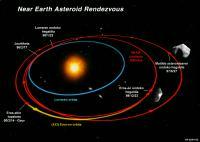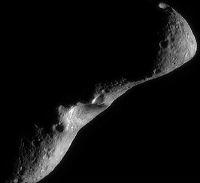Asteroid craters Matilde
2000/01/01 Elhuyar Zientzia Iturria: Elhuyar aldizkaria
Matilde was discovered in 1997 by the NEAR (Near Earth Asteroid Rendezvous) spacecraft. It is the oldest asteroid ever found, 53 km in diameter and very low density, making it a porous asteroid. But the most surprising and interesting thing about Matilde are the 5 craters (the largest is 33 km deep), whose characteristics do not correspond to the theories about the formation of craters.

Craters are produced by strong shocks, caused by impact and energy released, when matter has been thrown into space. However, these violent shocks leave remains around the craters and part of the matter thrown from the asteroid falls back to the asteroid and accumulates around the crater. However, there are no indications about Matilde's craters. To explain, Kevin House of Washington University has published a new theory. He extrapolated the results of laboratory simulations and said that Matilde craters were created by compression of surface matter. The energy generated in the shock would not throw matter into space, but the asteroid would absorb the material from the skin inward, thus creating the crater. Therefore, there is no trace on the skin, since instead of pulling the matter is absorbed.
The one responsible for this particular behavior would be the porosity of the asteroid. University of California researcher Erik Asphaug explains the lack of surface strokes in a different way, also using laboratory simulations and discovering that the material can be projected at a very high speed as a result of collisions in porous bodies. In this way, this material will not fall back on the asteroid and there will be no trace.

Gai honi buruzko eduki gehiago
Elhuyarrek garatutako teknologia






